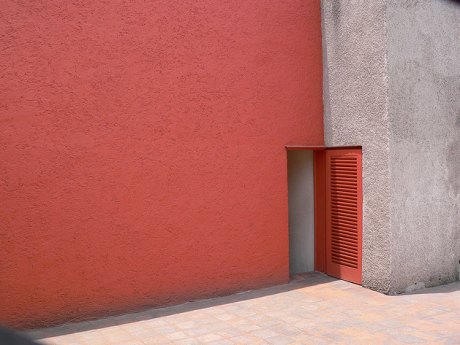
Barragan House, (Casa Barragan), Mexico City, Luis Barragan architect
“But you can’t allow a contradiction to stand! — Why not?…
Ludwig Wittgenstein
“Disneyland is a work of love. We didn’t go into Disneyland just with the idea of making money.”
Walt Disney
When Luis Barragan won the Pritzker Prize in architecture, the jury wrote “A stoical acceptance of solitude as man’s fate permeates Barragán’s work. His solitude is cosmic, with Mexico as the temporal abode he lovingly accepts.”
I remember when I first became aware of Barragan, I was probably about eighteen. I fell in love with the pink walls, the water, the sun off the blue or yellow facades, and the stables at Cuadra San Cristobal seemed the stage of a modernist play, a sort of tropical Beckett landscape. I was in love with Mexico at that time, too, so Barragan seemed the perfect architect.
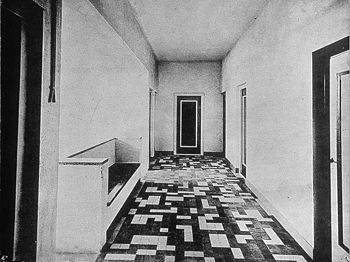
J.J.P Oud architect, floor design by Van Doesberg, Halls Holiday House
It was widely rumored that Louis Kahn consulted with Barragan about the spacing of the buildings at the Salk Institute. It makes sense when one looks at those structures. What is clear with Barragan is the influence of Moorish and Islamic architecture. The enclosed courtyard, the walls. Barragan’s walls, they are the walls of a monestary, but pink and yellow. These are monestaries of aqua blue waters and summer breeze. I love Barragan in much the same way I love Jean Nouvel. And it is not an accident that Nouvel designed one of the masterpieces of modern architecture, the World Arab Institute in Paris. There is an Islamic vernacular in Nouvel, and in Barragan both. But in Barragan the walls are not hostile, they are protective, and they are walls of humility. Still, it is a Mexican wall, of Mexican colors. It is protective but wary. The shadows….in Barragan one must always clock the shadows.
Barragan, in a trip to Europe in 1931-1932, met and studied some with Le Corbusier, but perhaps as importantly, he met the German Max Cetto, who had studied with Hans Poelzig, and was intimate with Bauhaus thinking. That there is a link between Barragan and Poelzig is one of those wonderful small discoveries, a tiny puzzle piece one has thought lost. But there is another influence, which Enrique Browne very perceptively points toward, and that is DeStilj, the Dutch movement of artists and designers, and architects from the early 20th century. Barragan certainly knew of surrealists like Delvaux and DeChirico, and his love of the Alhambra led him to Arab building ideas, but there is an unmistakable influence of J.J.P Oud and Jan Wils, too. Barragan imitated the Dutch architects pictorial use of color (De Stilj designers often worked with painters such as Mondrian and Theo Van Doesberg).
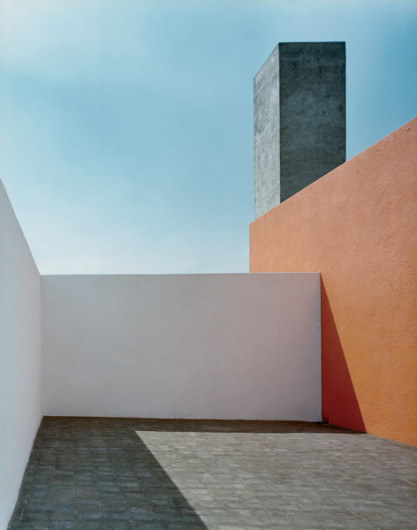
Barragan House, 1948, Mexico City, Luis Barragan architect
Jonathan Glancey, in a Guardian review of a Barragan retrospective in 2001, wrote:
“The life-enhancing chapel is achingly beautiful inside. Yet, like so many Barragan buildings, it is ultra-modern, while realised in the simplest materials – in this case adobe, timber and limewash. When Barragan uses the strictest rules of geometry, it feels as if Mies van der Rohe has come out on holiday to Mexico, knocked back a few tequilas, relaxed, coated his steel-framed buildings in thick mud walls and then painted them pink.”
This is very funny because its very true. The ‘achingly beautiful’ remark is true, too. There is no other architect, none, who makes my heart ache the way Barragan does. It is unbearable for a moment, sometimes. Something, something has just left the house. Something better than ourselves.
Barragan’s genius cuts close to an overwrought color saturated kistch, as his worst imitators fall into. Barragan is majesterial, but he has not been a great influence on architecture, I don’t think. At least not yet. And I say not yet because something tells me, if only through great misdirection, that Barragan’s generous, and languid, yet also devout religious vision is going to creep into cultural work, perhaps in film, after an odd several decades delay. Somewhere, someone is digesting and meditating upon the work of Luis Barragan, and I just suspect that someone may find Barragan’s pictorial sensibility very useful. Barragan is housed in our youth, in everyone’s youth. I think the young know this by instinct, while the mature know it from hard experience.

Studio, Luis Barragan, architect. Mexico City, 1948
I love Jean Nouvel, too. The Institute du Monde Arabe (Arab World Institute, Paris) built in 87, is one of the great modern buildings. His design for the Guthrie Theatre in Minneapolis (2006) is a very fine modern theatre, despite my misgivings about almost all modern theatres. As architecture however, leaving aside a complex of questions I have on theatre design, it is an oustanding achievment. All of his work, the public housing project in Nimes, France, (1987) is among the best designs of its kind, and the Quai Branley Museum in Paris is typical of Nouvel in a sense, for while I admire it greatly, I find it raises questions, and perhaps that is part of what is so impressive about his body of work.
One of the questions that all discussions of architecture raises has to do with the idea of “commons”, or public space. There has evolved, it seems, two sort of related ideas or definitions of public space. One is a space for consumption — malls, or shopping centers, or amusement parks. The other is a societal space in which segregation of classes is foregrounded. This second idea has evolved into spaces of control and surveillance. If one goes back to the 19th century, post industrial revolution, the definition of public space was white male public space, or at least public space in which affluent white men could dictate the terms of exclusion
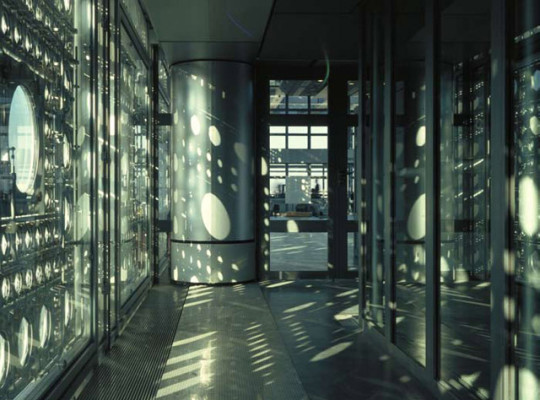
Institute du Monde Arabe, Paris, 1987, Jean Nouvel architect
In the latter half of the 20th century, the idea of public space has been marketed as inclusionary, but in fact this rhetoric has been a thinly disguised return to very elitist ideals. The homeless for example are never welcome in “public spaces”. So this can be seen as a triumph of marketing and PR. The architects of the late 20th century have increasingly blended these two currents, allowing for a special sort of economic low end ghetto/barrio/white trash Wal-Mart-ized Food-for-Less garage sale classification of consumption space. The crap super markets of poor neighborhoods for example are really much like company stores from the early and mid 19th century.
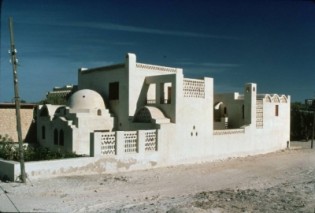
Halawa House, Abdel-Wahed El-Wakil architect
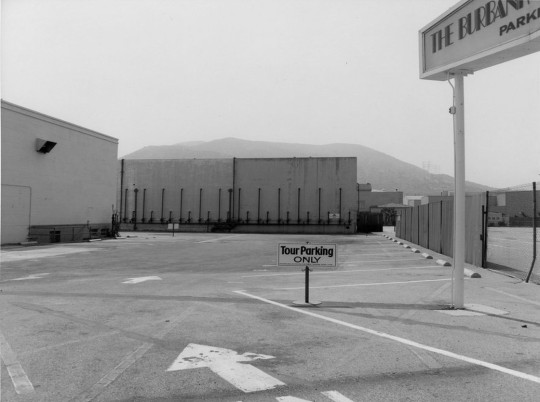
Frank Gohlke
The policing of public space has actually followed the model implemented by Disney at this theme park. Times Square or Hollywood Blvd, or downtown Anytown Kansas are all policed to keep outsiders off the street. The desired effect is the squeaky clean sobriety and whiteness of Disneyland. Now to return to archictecture and public space; the architecture of Disneyland is intentionally ahistorical. It is also, to echo Jonathan Crary, a perpetual vacuous “now”, a constant repetition of the same. History doesn’t happen at Disneyland, notwithstanding Frontierland, where Native American genocide is unsurprisingly absent. History is a cartoon, it is only another version of the present. Really, the main activity at Disneyland is eating and shopping. People are additionally being trained to follow directions to the next attraction, and to accept the pre-arranged eating break, or shopping interruption. Follow the lines on the asphalt, or the nice Guide’s directions. That Disney himself was a rabid far right wing racist, and an FBI snitch, is hardly a surprise. This was the WHITE dream of a middle class that believed in the fantasy of self advancement and hard work, of a Norman Rockewell white nostalgia for what never was. And it was deeply, profoundly authoritarian.
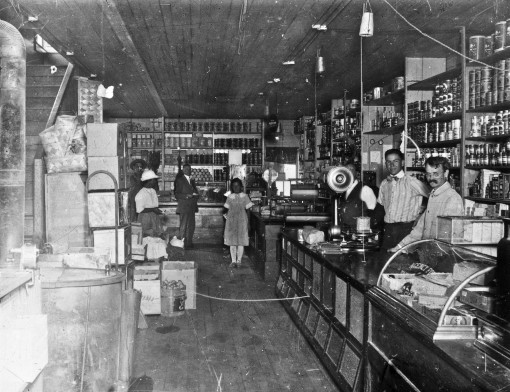
Eatonville Lumber Company Store, 1916
The designing of public space in the later part of the 20th century was attached to the residue of a Disneyland aesthetic and political vision of safety. And safety means fear. It was a fear of those who might come from the margins to have a good time on Main Street, and eat funny smelling food, and wear funny clothes and speak with accents. The architecture of this vision can be seen in the trend toward giant shopping centers, and sports centers, and all with a sense of a fortified perimeter. Whether brutalism was born of this is debatable, but certainly public space was altered by the sense of collective fear. The regional and often seasonal amusements of summer fairs and carnivals, or holiday markets was being eclipsed by the real estate developers like Disney, who saw city planning as exercises in police control, surveillance, and class divisions and exclusion. And of a never changing controlled “entertainment space”. In a sense the vast U.S. prison complex, the thousand prisons nationwide, are exactly in line with how shopping malls are built, how schools are built, and how sports stadiums are built. Buy a ticket, get a seat assignment, and sit at your desk. If you have any actual choice, it is only in where to eat or shop, and that is pretty carefully restricted as well. The aesthetics of the ownership class is shaped by land developers, too. One of the poignant things in the photos of the New Topographers (Stephen Shore, Lewis Baltz, Joe Deal et al) was the documenting of the sameness that had taken over the entire country. Baltz’s photos of industrial parks in Southern California were evidence of just how little difference there was between Rodeo Drive, Irvine auto mechanics or software firms, and Disneyland. There was no history, only a sort of bland amorphous generalized idea of place. There were signifiers for Europe, or the tropics, or Latin America, or even for wealth, but the buildings were creating the same space, the same proportions for cosmetic detail, for practicality, and for SAFETY. This spread to the Southwest, to the new South, to the bigger cities of the north east. Perhaps the most remote areas were what is now called ‘the rust belt’, in which urban decay became a default style code.
Michael Graves was, in a sense, the culmination of the pointless architectural detail, meant to provide targeted associations. In another sense, Las Vegas is a useful comparison as well, for Vegas more and more resembled both Disneyland AND Rodeo Drive, AND a super max prison. Graves didnt pay homage so much as insert graphic cards almost, pointing to a clear meaning in his buildings.
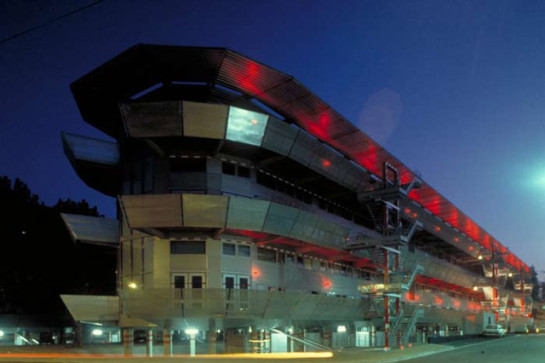
Public Housing, NImes, France. Jean Nouvel, architect 1987
The drive toward a certain aesthetic is embedded in that fusion of Capitalism and shopping. Even as Capitalism morphs toward something more to do with the production of attention, and the harvesting of attention; shopping remains the primary reflex. Diane Ghirardo : “The mall may have become the paradigmatic building type of the late 20th century where the distinctions between cultural and economic institutions have failed beyond recognition”. As she points out also, the design of museums became ever more linked to product sales and branding. But then everything became more linked to branding. The sub-conscious impulse for protection runs through the collective like a fever producing virus, like aesthetic streptococci, and it is the more remarkable when exceptions crop up (Indian architect Charles Correa, a stunningly sensitive and, really, visionary architect, did the Neru commerative museum in Jaipur, the results were exceptional in that the entire compound came to seem a memory from shared history, and perhaps that is the greatest thing a public can do. Correa additionally was a sort of prophet of the use of weather, cooling breezes to warming morning sun, his buildings eschewed AC and central heating). What is more revealing, probably, than the big projects of celeb architects, is in looking more at how domestic space and the housing of the poor, and the undesigned evolve, and then the relationship between public space, commons, and private lands.
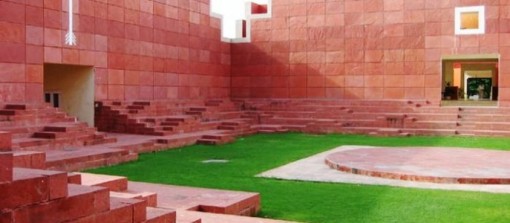
Jawahar-Kala Kendra. Charles Correa architect
The Indian architect B.V. Doshi, created (with painter Maqbool Fida Hussain), in a public park, a sort of underground art gallery, a grotto for escaping the Indian summers of Ahmedabad. It is an interesting, that even with the consumption aspect (food is upstairs, for sale) there is a counter training going on…for what are people being trained for in such public park areas? The gradual but incessant erosion of city parks in the U.S. can be seen in both how the public defiles public lands (http://www.theblaze.com/stories/2013/10/18/scout-leaders-destroy-170-million-year-old-rock-formation-in-state-park-to-save-lives/) and the destruction of public lands by a rich elite, either to preserve for their own ski holidays, or befoul by extraction of natural resources. The public, through the absolute destruction of education, and the constant drumbeats of consumerism, a society now so morbidly overweight, so chemically tranquilized, and so ignorant of even the most basic facts of history and geography, that I think in the U.S. very few people will lament the encroaching on public lands by resort investors or the propriator class with its various ventures. The public in the U.S. has the hardest time of all with silence, and reflection.
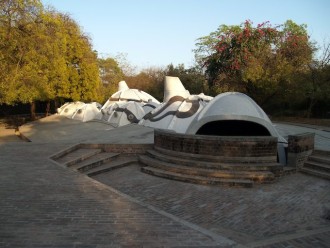
The Hussain Doshi Gufa, Ahmedabad India
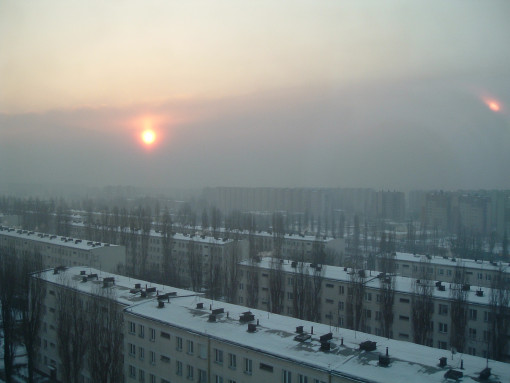
Nowa Huta (Krakow) Poland
More significant in a sense, for this posting, is the conceptual uses to which public commons are subjected. And an aesthetic borrowed from and shaped by the culture industry, has meant the acceptance of the “naturalness” of technological intrusion into our daily lives, and the acceptance of the “naturalness” of being asked for papers (the conditioning that results in people carrying their wallets and purses everywhere not so much to buy something, as to provide proof of who you are). I dont think it can be over-emphasized just how profoundly Hollywood has shaped ideas about technology. There is a devout belief in technology in Hollywood narrative; perhaps the result of film being such a technologically dependent medium.
But there is something else, too. There has been a rise among the affluent class, in the use of plastic surgery. In fact the popularity of plastic surgery has trickled down to the upper bourgeoise. (Richard Raznikov has a piece related:http://lookingglass.blog.co.uk/2014/01/05/getting-more-uglier-17551227/). There is something about the difference between an ideal and a mean. This extends to all aesthetic appreciation now I think. The public has come to equate ‘quality’ with a seamless efficiency of presentation. But not even that, it is more a generic quality that is valorized and applauded. The same with plastic surgery. The same with architecture, or architecture for the masses. For what distinguishes classes is that the elite class get Gehry, the lower classes get generic pre-fabricated prison style buildings. In a sense this is very obvious. It costs more money to build a Disney Concert Hall than it does to build a Food-for-Less market. Or a Pay-Less, or a Wal-Mart. But the ruling ownership class has started to resemble, through plastic surgery, the facial equivalent of a Stater Brothers super market. There has always been this creepy sort of bio-political transference, or really primal mimesis, that goes on throughout the process of domination. Hitler’s gestures becamse more and more a caricature of Jewish merchants, and in another way, George Bush the Junior began to act, physically and vocally, like those he was executing. Colin Powell became more and more like Dwight Eisenhower. But Im wandering… my point was that the public’s general sense of beauty is connected to their general sense of quality, and of how to evaluate narrative and artworks (entertainment). If in the U.S. there has been an 87% increase in plastic surgery since 2000, and if last year there were 14 million cosmetic procedures, at a cost of 10 billion dollars, then its not hard to imagine something of a perceptual shift in “ideal” beauty. Except I don’t think that’s the case. I think there has been the erosion of the idea of an “ideal”. The mean, people are reaching for the mean, the most “acceptable”, the totality that seems most seamless. Botox increased significantly, providing that expressionless look of generic blankness that seems so desired. Mentoplasty is up (chin tucks) and of course old favorites like nose jobs and breast augmentation. There is also a significant rise in surgery for teenagers. Now, I dont make to light of the suffering that people can endure from actual disfigurment or abnormal physical conditions. I’ve known some, and it’s terrible. But I’m looking at FOURTEEN MILLION procedures. Fourteen million. That is a lot of people. I once went to a dinner party in Bel Air, at the home of a famous plastic surgeon. I didn’t know anyone but my girlfriend at the time did. The party was for the wife of the surgeon. And a lot of his clients were invited. Not surprisingly I guess, everyone looked the same. Or a lot of people looked the same. The women ALL had large plastic breasts (and clearly if you get a boob job you are going to display it). It was a disturbing evening.

Hilo Chen
I guess my point here is that that Botox expressionless face, the augmented body parts, the wrinkle removal, all contributes to the facial equivalent of an after school special, and here again that sense of generalized autism, first mentioned by Debord, but independently raised by myself, seems to gain relevance. Blankness of appearance is an extension of inner blankness, of an inability to integrate mimetic processes, and the narratives, the films and artworks must also be blank, of without affect, and this is expressed by incompletion of a certain sort, and interruption, and just obsessive repetition. The post modern emphasis on surface is in line with, if not created by, the market forces of rhinoplasty and dermabrasion. The desire for the mean is, then, an expression of inner numbness and probably of fear.
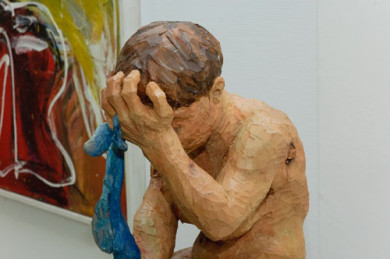
Walter Stoehrer
As a sort of coda to this, I have been thinking a lot lately, again, about the ways snark and sarcasm work, but more, about a smugness that sort of permeates various sectors of the society. I know, and have at least cyber relationships with a lot, LOT, of young leftists, and most of them, if not almost all of them, are University educated, and from comparitevely privileged backgrounds. The majority are very smug. This over confidence is born of privilege. The poor don’t have it. They just don’t. The poor can be arrogant sometimes, but its usually a transparent defense mechanism. The educated upper 20%, and I’m speaking of self identified leftists, Marxists, socialists of some sort or other, are extraordinarly smug. Now, looking back over decades, I see that most similar young educated radicals ended up in well paying jobs, and their radicalism waned, if it didnt just do a 180 degree turn. For smugness so easily becomes a belief in one’s deserving qualities, one’s destiny to lead, or reap rewards. Lawyers, doctors, hedge fund managers, import-export CEOs, and even just journalists (in one case anyway), and several shrinks. In each case their politics were adjusted to fit better with their material success. These were all people who in college or at University were politically radical. All were very smart. Literate and articulate. But they were all snarky and smug. For the belief that lies barely concealed under a youthful smugness is one that says, I am special. I am destined for success, and who am I to fight it. Im smarter, more articulate, whatever….sexier, more insightful, etc. So, it is worrisome that so many on the left express a snarky smug condescension. (First off, anyone under thirty should never ever condescend to anyone).
The people I have known who worked as activists and community organizers, prison reformers, radical writers and teachers were in almost every case from poor backgrounds. They committed to social change, regardless of it not likely making them any money. For those smug radical college students, a life of political activism would mean GIVING UP privilege. It would mean having to save to buy a nice IWC watch, let alone a new BMW or Porsche. It would mean not having a cool comfortable house in a trendy area. It would mean not having a good table at Le Bernadin or 11 Madison Ave. Giving up a class privilege is not something many people, ever, will do. It’s just not. Now, I guess this is a small sample size, but not that small.
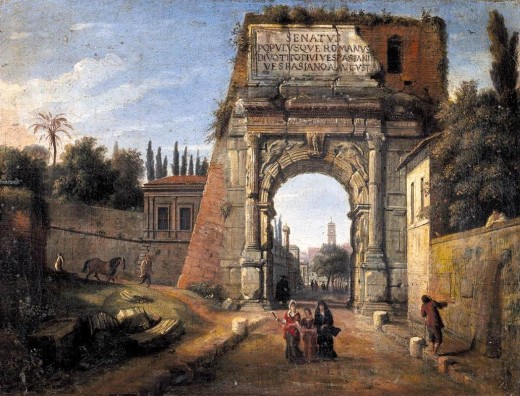
Gaspar Van Wittel
That is one factor. Just the fact that if you have those family connections, if you go to an exclusive school, its pretty hard to avoid finding ways to justify working as a lawyer for Dow Chemical. Now, of course I have known some who went on to work on small farms, and to develop alternative models of sustainable living. Almost all were young women. I think men are too deformed emotionally in the West. For men, white men, the road to success, if offered, is not going to be turned down. It’s just too validating, and self image is too propped up, desireability, feelings of worth. It’s easy to buy into this. Even if one has ridiculed all this material advantage — once the idea of NOT taking it, not accepting what one’s family has groomed you for, it is an impossible task. I bring this up because I think the left in general has to start a self critique that includes a hard look at their own privilege. And a look on what cooperation means. The work Ive done in radical politics, or education, or even in the arts, my experience has been that finding people to really do what they say, to commit and mean it, is perhaps the hardest single thing to find. In Hollywoood, needless to say, its NON EXISTENT. And if movies are being made by the sorts of ethical road kill that I knew in Hollywood, then no wonder we are a violent compassionless, and selfish society of moral pygmies.

Toy factory worker, China, Michael Wolf photographer
“Cooperation”. Learning to not alienate. Learning to check yourself. And perhaps behind this all is that most of important of exercises, discovering and clearly identifying who the enemy is. The left today, the snarky white University left, often seems to NOT know who the enemy is. Everything feels like small battles of ‘cool’. The small sectarian wars, and meanwhile, the actual work for change, even if that means just working in arts, or organizing on the most mundane level, or teaching, any of it, any of all that vital work remains ignored.
The spiritual dimension of teaching, of that complex dynamic in arts, but in all educational dialogue, often seems lost today. This is the other side effect of smugness. The failure to appreciate the gift of finding good teachers. It is easier to teach, I think, in the end, then it is to be a good student.
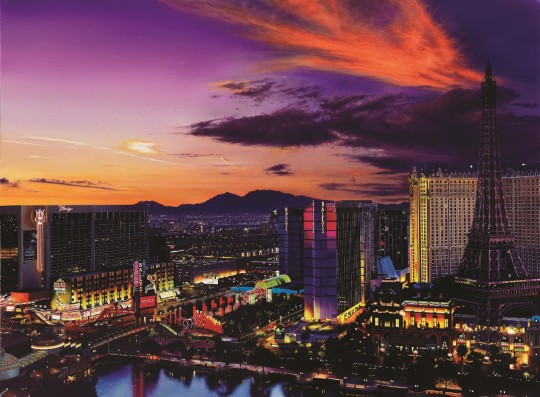
Raphaella Spence
There are, I think, aspects to culture that run counter to much leftist dogma. The monastic hierarchies exist in some fashion, I think, but they are confused under capital. For capitalism is really the problem. It is a constant hammering away at a message of “take take take take…”. Profit. Dog eat dog. Winner take all. Winning isnt everything, its the only thing. And on and on and on. Let them eat cake. I think what should be obvious is that if you are a practising snarkmeister, its going to be hard for anyone to trust you. The nature of verticality is not totally abhorent. It is just that is always couched in the most vulgar capitalist terms. In a sense, you first need a socialist frame, to allow the organic and spiritual aspects of rigor to flourish, and that means at times a sense of the monastic. It is often not about free play of orgiastic energies. I mean, sure, Id like that, too. Im all for it. But education must also exist in some kind of verticality. But as I say, this cannot exist, or even be talked about, before the Revolution. Which isnt hyperbole. This is a topic I want to write more about, but I wanted to touch on a couple of news items right now. A news report out, or rather resurfacing, about Israeli eugenics.
http://www.forbes.com/sites/eliseknutsen/2013/01/28/israel-foribly-injected-african-immigrant-women-with-birth-control/
I am reminded of the Bush family links to eugenics, to I.G.Farbin industries, and to international banking;
http://www.informationclearinghouse.info/article3255.htm
There has always been a stark eugenicist strain to American racism. It fit in so comfortably with ideas of progress and science. Today this same desire to wipe out the undesireable population can be found in a resurrgent Malthusianism. The over population myth now comes in an enviornmental clothing. An eco friendly racism. When people talk about a “finite system”, that there are “too many people”, the image in their brain is of Soweto or Lagos or the slums of Nairobi or Sao Paulo, not of the white dominant metropolises of New York or London or Sydney. Over population is always a specific over-population.

William Shockley. Noble Laureate, Eugenicist.
Prescott Bush, Averell Harrimen, John Foster Dulles and Allan Dulles, John D. Rockefeller, Will Draper, William Shockley; these are a few names one can google and find connections to Nazi theories of racial hygiene. The Queen of England used to visit the US and stay at the home of Kentucky horse breeder Will S. Farish III. Farish’s grandfather worked with Prescott Bush in deals with I.G.Farbin Industries, and had close ties with John D. Rockefeller, and even was head of Standard Oil for a while. Averell Harrimen’s mom was a big eugenics believer, too, and gave a good deal of money to the cause. The point here is that these are the values of that white WASP elite that laid the groundwork for a future police state, one that is now pretty much a reality. The old man Farish was actually tried in court for criminal conspiracy after WW2. He pleaded no contest. Prescott Bush escaped all prosecution.
But as another example of this thinking that runs through U.S. history, there is this: http://www.uvm.edu/~lkaelber/eugenics/NC/NC.html
and this: http://m.journalnow.com/news/local/article_c3233614-8fe7-11e2-9446-0019bb30f31a.html?mode=jqm

“Adventureland”, Disneyland 1960.
So, next time someone wants to get misty eyed about the Queen of England, do recall her savagery toward the poor, her contempt for all but elite white people, and her fondness for dictators. She loved Pinochet, and Ian Smith. And she was close with all those trying to further what are essentially Nazi social policy. The same of course for ol Dubya, who enjoyed his time as Governor of Texas because he could oversee the execution of 154 prisoners at the infamous Texas Death House. Remember too, that the European fascists, those who founded the modern Olympics, which I’ve written about here:
http://john-steppling.com/?s=let+the+games+begin
These were the same people embraced by Mussolini, and Franco. The Catholic Church plays a huge role here, too. The romanticizing of royalty in the U.S. has never stopped being an amazement. I mean what fucking good do any Royals actually do? Why is there so little animus directed at them? But I digress…
I bring up the Bush family crimes to point out the obvious. The propriator class, the rich white aristocracy in the U.S. are rich in ways that go beyond bank accounts. The Rockefellers and Bushes and the Dulleses, Vanderbilts, Hunts, and those on The Trilateral Commission, or participants of the Bilderberg Group meetings; these are the definition of fascist, and these are the people with vast influence.
“The intention behind each and all of the Bilderberg meetings was about how to create an ‘Aristocracy of purpose’ between Europe and the United States, and how to come to agreement on questions of policy, economics, and strategy in jointly ruling the world. The NATO alliance was their crucial base of operation and subversion because it afforded them the backdrop for their plans of ‘perpetual war,’ or at least for their ‘nuclear blackmail’ policy.”
Daniel Estulin from his book “The Bilderberg Group”
But there are others, The Pilgrims Club, the Club of Isles, or the Council on Foreign Affairs, World Bank, WTO.
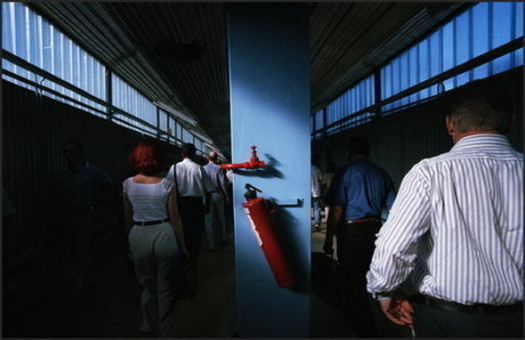
Gueorgui Pinkhassov
“In November 1990, under pressure from the Bush administration, the U.S. Congress passed the Foreign Operations Appropriations Act… They were deliberately lighting the fuse to an explosive new series of Balkan wars. Using groups such as the Soros Foundation and NED (National Endowment for Democracy), Washington financial support was channeled into often extreme nationalist or former fascist organizations that would guarantee a dismemberment of Yugoslavia…The stage was set for a gruesome series of regional ethnic wars which would last a decade and result in the deaths of more than 200,000 people.”
William Engdahl
“A Century of War: Anglo-American Oil Politics and the New World Order”
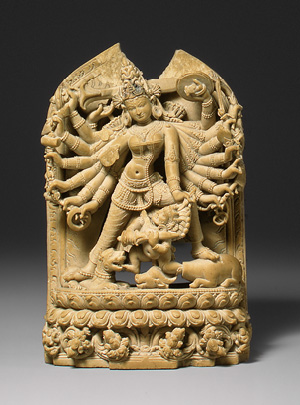
Durga, killing demon. Pala Period, 12th century Bangladesh
But these are not the organizations one sees in pulp espionage novels, or TV shows, or Hollywood film. The recent Lone Survivor, directed by the odious Peter Berg, is essentially a military recruitment film. But it is additionally a cartoon history of current US wars. The narrative today, around fascism, excludes real time fascists. It is now a quaint corner of history that nobody need worry about anymore. Mention “fascism” and people think of 1940s style, cool men’s hats, and WW2. Why are Hollywood stars taking jobs in such loathsome product as this Berg vehicle? Is Eric Bana broke? Is Wahlberg really that reactionary? Is his being short really an excuse? Today the left, often shies away from the word fascist. Oh, thats not accurate…followed by a long dissertation on the semantic history of the word, or some long explanation of the Italian origins of fascism, etc. The reluctance to use the word has always sort of baffled me. The fascists are everywhere you look. The new feudalism has meant the puppet play of electoral politics takes place as a sort of court entertainment. For behind most of US foreign policy are the centers of wealth and power I mention above.
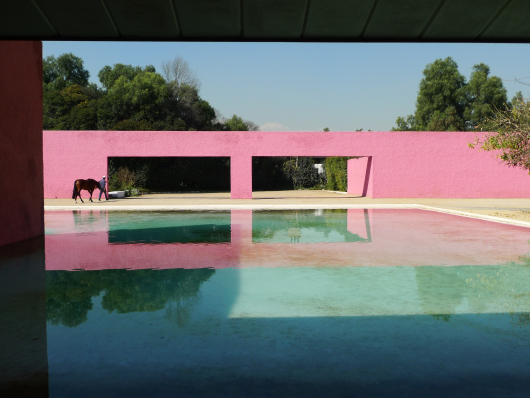
Cuadra San Cristobal, Luis Barragan architect, 1966

Good read. Resonates to my thoughts and perception of the world and cultures.